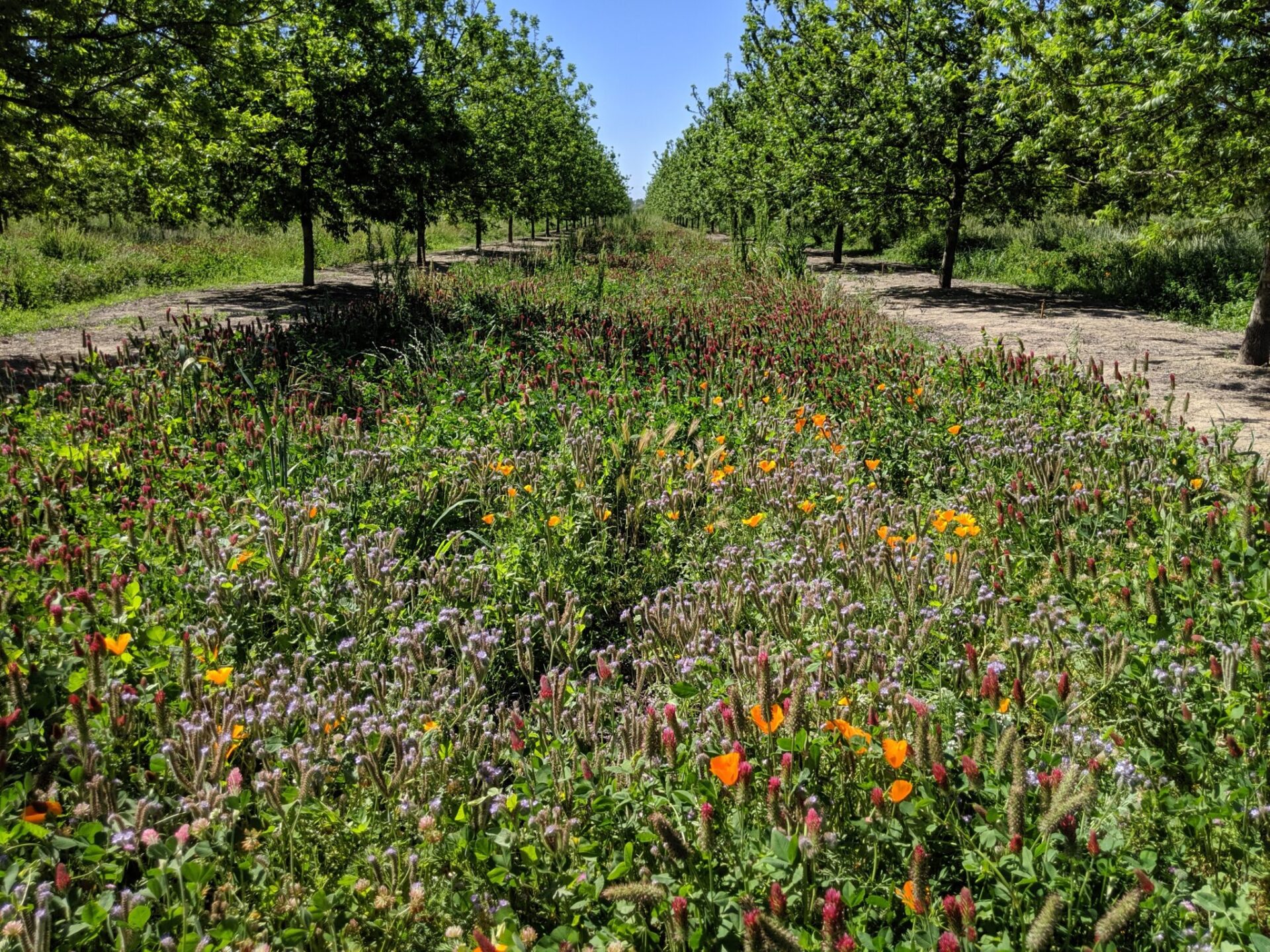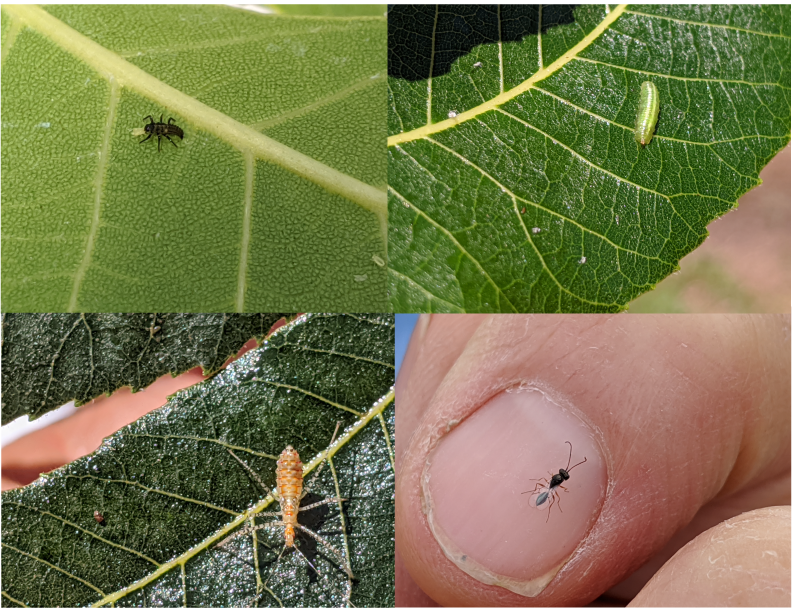
This article discusses planting and managing a cover crop mix in pecan orchards to attract beneficials, which provide some control of two species of pecan aphids. Controlling aphids in pecans with chemicals generally requires two to three spray applications over the season. To date, the grower has saved 1-2 sprays, and learned that alternate row mowing of the cover crop can extend the flowering and, therefore, the availability of nectar and pollen for supporting a wide variety of beneficial insects which suppress aphid populations.
California Wildlife Conservation Board has funded a collaboration between the Environmental Defense Fund (EDF) and the National Center for Appropriate Technology (NCAT) to work with two pecan orchards: one at PacGold in Colusa, Calif., owned by Ben King, and one at Bypass Farms, managed by Ammy Reyes, on the north side of the Sacramento River, just east of Route 5. The goal of this work is to develop habitat in or adjacent to the orchard that can support beneficial insects, including monarch populations.
Subhead: Natural Aphid Predators
Major pecan pests in California orchards include a couple different species of aphids: the yellow pecan aphid and the black margined pecan aphid. The yellow pecan aphid is the more benign pest of the two aphid species and generally appears first in the late spring and early summer. Unless honeydew generated by the aphids becomes a problem, the economic threshold for the yellow pecan aphid is an average of 20 aphids per compound leaf during this time of year.
Treatment guidelines:
- Before June 1: Apply an insecticide if honeydew is accumulating.
- June 1 to August 15: Apply an insecticide if the total number of aphids exceeds an average of 20 per compound leaf.
- August 15 to leaf fall: Apply an insecticide if the total number of aphids exceeds an average of 10 per compound leaf.
To date, the cover crops have saved the grower at least one spray, perhaps two (See Table 1 for cover crop species mix and comments.) The hope is to go the whole season without spraying. However, the NCAT team does weekly monitoring of aphids in the pecan canopy. This information provides the grower with some good information for making spray/no-spray decisions.


Sampling for Aphid and Beneficials
We select 3 compound leaf samples from each of the 20 trees located around the 200-acre orchard, and count the aphids, as well as green lacewing eggs and other predators such as all life stages of lady bird beetle, assassin bugs, syrphid flies and spiders. The aphid counts are listed in figure 1 by date, and have not yet come close to approaching the economic threshold of 20/compound leaf. But conditions can change quickly in hot weather, so it’s important that the grower have weekly updates of aphid counts. The aphid populations are being managed by the changing array of predators, including very tiny spiders. These tiny spiders feed on the first and second instars of the aphids, just as the just-hatched lady bird beetle larvae do. Small predators, small prey. Having a diverse array of predators and parasites, with different prey and host preferences, provides dynamic and flexible aphid suppression.
We also have done sweep sampling of the cover crop every two weeks at 10 different locations in the orchard, mostly looking for predators and parasites—adults and larvae of green lacewings, syrphid flies, lady bird beetles, tiny parasitic wasps, six-spotted thrips and other various predators.

We’ve hung sticky traps in 10 trees around the orchard, and collected them and counted beneficials on them every two weeks to better understand what critters are migrating from the cover crop into the pecan canopy. We’ve found many green and brown lacewing adults, other predators and many species of small, parasitic wasps.
Beneficial Habitat
Alleys in orchards are underutilized as habitat for beneficial insects. What we found was not surprising. Planting cover crops in the alleys can provide nectar and pollen resources for a wide range of beneficials, some of which migrate into the pecan canopy in search of prey. It’s good to remember that cover crops, which require management inputs, are an investment in the biological system of checks and balances which supports populations of parasites and predators of aphids and other insects. Investments such as seed costs, planting costs and other management considerations like mowing costs can have significant returns.
There is, however, a learning curve related to how best to manage the cover crop. Knowledge about when to plant the cover, what species to include and when to mow will be informed by experience. If you’re interested in planting cover crops, there are many resources available to farmers about planting cover crops, including NRCS, RCDs, NCAT, other non-profits and seed suppliers. For example, we found mowing alternate rows is less disruptive to beneficial insects. Cover crops are also an investment in the soil, supporting a healthier soil, which will store and cycle nutrients more efficiently, and absorb and store more water.
Due to their long growing season and late harvest, pecans are ideal locations to plant cover crops. They’re generally harvested in October, and if the trees are irrigated with microsprinklers, cover crops can be grown in the alley for several months to attract and maintain populations of beneficials. Alternate mowing of alleys, spaced about every two weeks, can allow cover crops to go to seed, and at the same time help to extend the time flowers can provide nectar and pollen resources for the beneficials.
Resources:
Overview of Cover Crops and Green Manures
http://attra.ncat.org/product/overview-of-cover-crops-and-green-manures/
Cover Crop 340 for Organic Systems.
http://attra.ncat.org/product/cover-crop-340-in-organic-systems/
Cover Crop Options for Hot and Humid Areas
http://attra.ncat.org/product/cover-crop-options-for-hot-and-humid-areas/
For more information about this project, contact Rex Dufour, rexd@ncat.org, or 530-792-7338. For information about a wide range of sustainable and organic practices, visit NCAT’s ATTRA website at www.attra.ncat.org.










